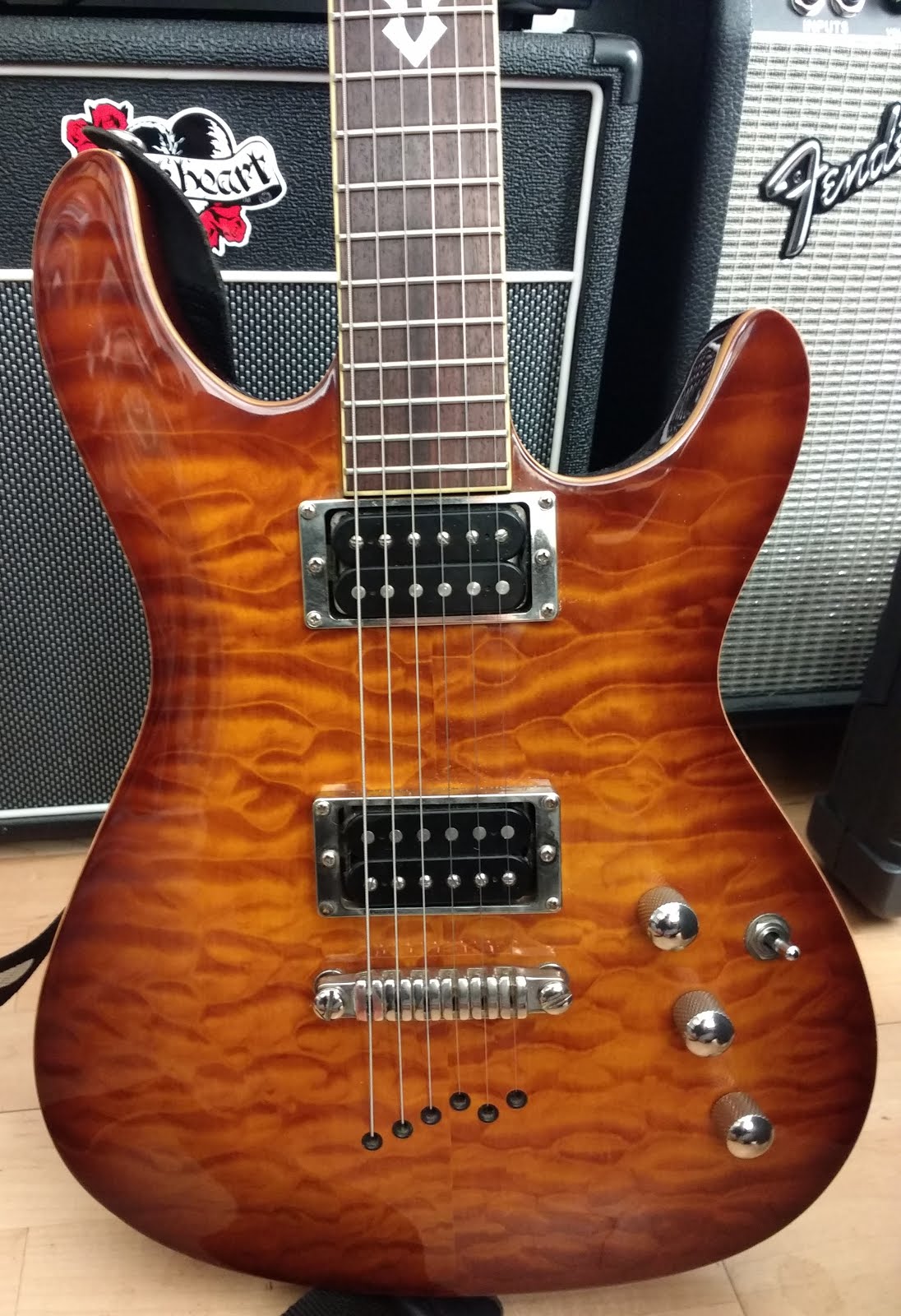The most recognizable guitar design in the world, it has been used by millions of guitarists for over half a century. Debuting in 1954, it was a natural evolution to the Telecaster. Featuring a double cutaway contoured body and more versatile pickup and wiring options, it quickly became an icon that soared to the 'stratosphere.'
- Ibanez Cavity Depth Bass
- Ibanez Cavity Depth Chart
- Ibanez Cavity Depth Scale
- Ibanez Cavity Depth Definition
This set of templates includes a body template, neck pocket template, neck template with vintage 60’s headstock, and pickguard template. It is set up as a hardtail configuration, to be used with a vintage style string through body or top mount bridge. The neck pocket template has a universal rout to fit either a P90, humbucker, or similarly sized pickup in the bridge position.
The body and neck pocket templates include registration holes along the center line. If you use screws to hold the templates to the wood you’re routing, the holes will help keep everything lined up between templates. They are located so that the holes will be hidden under the pickguard.
This is a nice original Ibanez cavity cover that was removed from a 2003- 2004 Ibanez RG370DX electric guitar. Included are all the original mounting screws. Conductive shielding is in place and intact. It has normal wear from average use. Check my other auctions.
Ibanez Cavity Depth Bass
- These catalogs are sourced from the Ibanez USA website's catalog archive, the Ibanez Japan website's archive and other sources. They are a primary reference for much of the information documented on this wiki.
- (c38) Guitar Termolo Cavity Back Plate Cover for Ibanez RX Series Black ABS. 3.8 out of 5 stars (4) Total Ratings 4, $5.50 New. 4pcs Neck Mounting Bushings Ferrules and 4pcs Screws Fit Ibanez GuitarC Chrome. 4 out of 5 stars (2) Total Ratings 2, $3.99 New.
- (Requires 1.35 in. (35mm) cavity depth) Ibanez JS-2480 guitar control cavity photo. Note that the cavity wall at the top of the photo has to be shaved a little to make room for the Sustainiac circuit board. This can be done in a few minutes with a good hand chisel. Hookup diagram showing the Aux-JS board in the Ibanez JS2 480 guitar.
Recommended dimensions and routing depths are:

- Neck Pocket Depth: 5/8'
- Pickup Cavity Depth: 5/8' (3/4' for some aftermarket pickups)
- Volume/Tones/Switch Cavity Depth: 1 1/2'
- Output Jack Cavity Depth: 1 1/2'
- Roundover Radius: 7/16'
Wanting to mod your Strat with an alternative control plate design? I have them here.
Trem Angle
EDGE PRO
EDGE/LO PRO
TRS/OFR
ADJUSTING
The new Edge Pro trems are the lowest profile Ibanez has cast to date, but as a result also sits deeper in their routes making the knife edge a little tougher to see to set the trem angle. On the new design they did make the top edge of the trem parallel to the bottom, which is parallel to the knife edge, so you can use a combination of a glimpse of the knife edge [if that's all you can see] and the top edge of the baseplate to judge the trem angle. Bottom line is you want to get the knife edge perpendicular to the stud [height adjustment bolt or the fulcrum the knife edge pivots on when the tremolo is used] and when the knife edge is perpendicular to the stud the knife edge is parallel to the top of the guitar, and the top of an Edge Pro is parallel to the top. This is a side view of the Edge Pro
The knife edge can be clearly seen as the black rectangle pressed into the side of the baseplate.
Here are 2 shots where you can see the top of the baseplate is parallel to the top of the guitar when adjusted correctly.
And up close you can see the sliver of bright knife edge running perfectly parallel to the top of the body. THIS is the most important measure if the trem angle is correct.
Ibanez Cavity Depth Chart

The Edge and Lo Pro have an angled baseplate where the top of the baseplate is at an angle in relation to the bottom. The bottom of the base is parallel to the knife edge and bottom line it will be the knife edge that we will be concerned with when setting the trem angle on Edge and Lo Pro trems. Setting the trem angle of your Floyd is very easy, it only requires understanding what to do. Your goal is to have the Knife Edge meet the Trem Post at a 90* angle (perpendicular).
The knife edge can be seen on the side where it is press fit into the base.
When the trem is in the guitar you might need to look down in the gap between the body and the edge of the trem with good light to see it.
Simply, when the knife edge is parallel to the top of the body, it will be perpendicular to the trem post (The trem post is the round grooved bolt the knife edge sits against). It does not matter if the trem is set deep inside the body where you can barely see the knife edge, or if it's very visible if the trem is screwed far out of the body, you want it parallel to the body top. (Different models and different guitars of the same model might have deeper or shallower neck pocket routs, or thicker and thinner neck heels, so each different guitar and type may setup slightly different. If it's been tweaked by a previous owner with a neck shim, etc. then your setup could look completely different) This is a Jem10th and almost all look exactly like this when setup properly.
As you can see the knife edge is parallel to the top of the body. This holds true for all flat top Edge or Lo Pro equipped guitars. If the top of your guitar is curved like an S series, you'll want to visually try to compensate for the curve you see in the top of the body, and get the knife edge to where it looks as perpendicular to the post as possible.
On the Floyd Rose type trem with a flat baseplate the knife edges are part of the baseplate itself. On a flat top guitar the baseplate will be parallel to the top as shown below.
Before you begin you must make sure the trem is set to the height you want (height of the trem determines the height of the action). You can make very small height adjustments and they won't have any effect on the angle but large adjustments will. Height changes affect tension and will change the angle. If the action is way too high or too low set the height before the angle by manually setting the angle using the bar while checking the height of the action, adjust, then manually adjust the angle again (using the bar) till the action height is close. Otherwise you will set the angle to perfect, have to change the action height, which will change the angle again. Now you are ready to set the angle.
If the back of the trem (where the fine tuners are) is sitting too low and the angle needs to be brought up, you need to release tension from the springs. Unscrew the screws that hold the spring claw to the body 1/8th to 1/4 turn. If it needs major adjustment it will take much more than a 1/4 turn, but for minor adjustments that will usually do. Retune to pitch and visually check the angle. Repeat as needed till the knife edge is perpendicular to the trem post.
If the back of the trem is too high and needs to be lowered into the body to bring the angle down, you need to screw the claw screws in 1/8th to 1/4 turn to increase the tension the springs apply. Retune to pitch and visually check the knife angle. Repeat until correct.
Ibanez Cavity Depth Scale
This is a shot of the trem, springs, claw, and spring claw screws (inside the trem cover, that cover with 6 screws in the back). Notice I always keep the claw parallel to the end of the trem cavity keeping equal tension across the plate and block. This is more an anal habit of mine but some argument could probably be made about having one spring pulled further than the other. Whatever the argument I like everything even with equal tension.
Ibanez Cavity Depth Definition
The more you do it the more you'll become familiar with how much adjustment your guitar needs in any given situation. Learning to rough tune quickly with a Floyd will save you much time. If the whole guitar is a half step too low, tune the low E up to G, A up to B, D up to D#, G to G#, B to B, and high E to E. It will end up much closer to 'in tune' than if you don't. Likewise if it's 1/2 step too high, lower the pitch about as far the other way, always working from the low E to the high E.
Typical setup for 9-42 gauge strings using the typically found 52mm springs found in most Ibanez. For 8's I'll usually use 2 springs in an arrow formation, outside holes on the trem block to the 2 inner hooks on the claw. For 10 gauge sets I always add a 4th spring although 3 will work if you have room to screw the claw far enough. With new springs you will, if the springs are ageing and fatiguing you might not. I much prefer the flexibility 4 springs give and people playing 10's usually like the extra tension anyway. To use 4 springs take off the spring lock bar and use it's screw holes so that the center slot is now empty. If you really want to use the spring lock you'll have to find springs with eyelets on both ends. They are made but I don't know where to buy them and have never used them. You can also use a set of the short 47mm springs for a 3 spring 10 gauge setup. Even heavier gauges may require a 5th spring but you can probably get away with 4 using an 11 gauge set. The new Edge Pro trem rout in much longer than the Edge or Lo Pro giving the spring claw much further travel, allowing 3 springs [or more] a much higher tension.
Some people like to set their trem to a negative angle as they feel it returns to neutral better. If it's not returning to neutral correctly it's time to address the reason it's not, not change the angle of the trem. If the trem has been properly radiused to the frets changing the angle from perpendicular will change the radius of the bridge as intonating the strings causes each string to break at a different spot. Stick with the correct trem angle and if you are having any problems with return fix the problem itself.
Comments are closed.